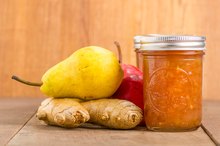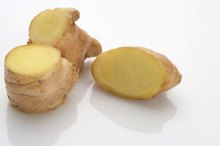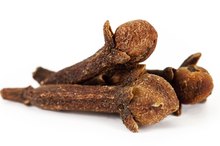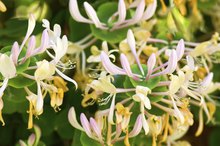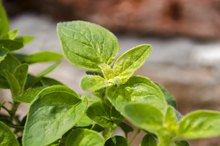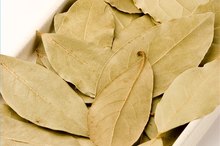The term "Hawaiian ginger" is ambiguous, since commercial production of more than one plant known as "ginger" takes place in Hawaii. Both the rhizome prized in cooking and the flower sought for decoration belong to the ginger family, or Zingiberaceae, so it's no wonder they share a name. However, one is edible and the other is not.
Hawaiian Production of Ginger Root
When you hear the word "ginger," you probably think of the flavorful root used as a spice in many varieties of Asian cuisine. Hawaii is unique among the 50 U.S. states in that commercial production of ginger root takes place there 1. Hawaii does not produce enough ginger to meet U.S. demand, however.
Making Ginger Root Edible
How to Make Ginger Preserve
Learn More
To produce the "hands" of ginger you're used to seeing in grocery stores, ginger growers must wash, dry and cure the harvested rhizome. Rough handling during washing can strip the skin off the rhizome and bruise the product. To avoid this, growers usually harvest ginger late in the season, after the above-ground portion of the plant has dried up and died. After washing the roots, growers transport them to screened racks in warehouses, where they dry completely and cure for a period of three to five days. Insufficient curing allows mildew to develop at the cut ends, while too much curing reduces the roots' weight and destroys the shiny skin surface that makes ginger root so attractive to buyers.
Ginger may also be harvested early, before the rhizome becomes very fibrous. This specialty product, known as "young ginger," is used for pickling.
- To produce the "hands" of ginger you're used to seeing in grocery stores, ginger growers must wash, dry and cure the harvested rhizome.
- Insufficient curing allows mildew to develop at the cut ends, while too much curing reduces the roots' weight and destroys the shiny skin surface that makes ginger root so attractive to buyers.
Ginger Overdose
An amount of 2 to 4 grams per day of ginger root is generally safe. More than that, however, may have uterine-stimulating properties. Controlled studies of animals and humans have yet to demonstrate ill effects on the fetus. Nevertheless, ginger in high or medicinal doses is contraindicated during pregnancy and lactation. Large doses of ginger are also not recommended for those suffering from gallstones and for the two weeks preceding surgery. Cardiac arrhythmia and depression are also associated with ginger root overdose.
- An amount of 2 to 4 grams per day of ginger root is generally safe.
- Nevertheless, ginger in high or medicinal doses is contraindicated during pregnancy and lactation.
Ornamental Ginger
What Foods Have the Herb Ginger in Them?
Learn More
The flowers fall under the genus Alpinia, named for the Italian botanist Prosper Alpinus. "White ginger" usually refers to A. zerumbet, also called shell ginger.
Uses for Ornamental Ginger
Generally, neither the blossoms nor roots of ornamental ginger flowers are considered edible. Instead, they are used in landscaping, flower arrangements and the creation of traditional lei necklaces. They are also used in incense production.
- Generally, neither the blossoms nor roots of ornamental ginger flowers are considered edible.
- Instead, they are used in landscaping, flower arrangements and the creation of traditional lei necklaces.
Alpinia Toxicity
According to the Pacific Island Ecosystems at Risk project, Alpinia purpurata is not toxic to animals 3. However, all parts of any Alpinia species are considered poisonous. Dr. Alice B. Russell of North Carolina State University writes that the leaves, stems and roots all can all cause cardiac effects upon ingestion. These effects are classified as low toxicity. Sap from ornamental ginger causes brief, minor skin and eye irritations.
- According to the Pacific Island Ecosystems at Risk project, Alpinia purpurata is not toxic to animals 3.
Related Articles
References
- University of Hawaii at Manoa Cooperative Extension Service; Ginger Root Production in Hawaii; M.S. Nishina, et al.
- University of Hawaii at Manoa Cooperative Extension Service; Ornamental Ginger, Red and Pink; Kent D. Kobayashi, et al.
- Institute of Pacific Islands Forestry Pacific Island Ecosystems at Risk; Alpinia Purpurata; C. Daehler
- National Center for Complimentary and Integrative Health. Ginger. Updated September 2016.
- Memorial Sloan Kettering Cancer Center. Ginger. Updated October 30, 2018.
- University of Texas, El Paso/Austin Cooperative Pharmacy Program & Paso del Norte Health Foundation. Herbal Safety: Ginger.
Writer Bio
Nicole LeBoeuf-Little is a freelancer from New Orleans, writing professionally since 1994. Recent short stories appear on Ideomancer.com and in Ellen Datlow's anthology "Blood and Other Cravings." She has published articles in "Pangaia Magazine" and eGuides at StyleCareer.com. She holds a Bachelor of Arts in English from University of Washington and attended the professional SF/F workshop Viable Paradise.
